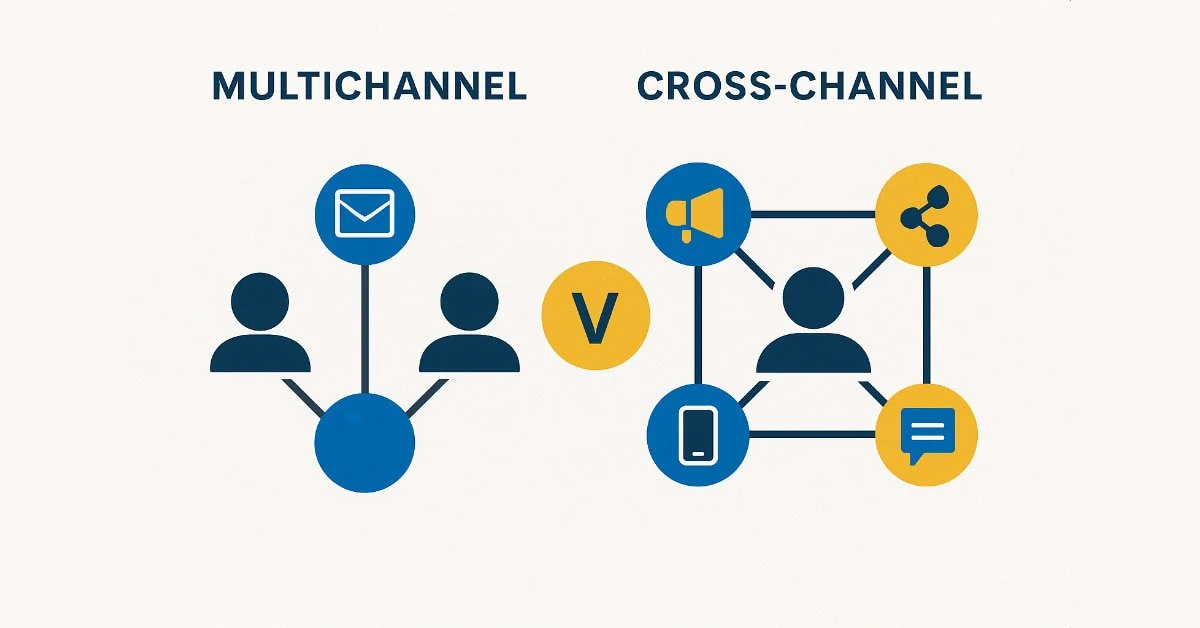Cross-Channel vs. Multichannel: Why the Difference Matters for Your Customer Lifecycle
Many businesses proudly claim they’re “multichannel.” They send emails, run ads, post on social, and maybe even add SMS into the mix. But just being in multiple channels doesn’t guarantee results. What actually drives growth and loyalty is how those channels work together. That’s where cross-channel comes in and why the difference between the two approaches matters.
In this post, we'll explore the differences between multichannel and cross-channel marketing, why it matters for customer lifecycle management, and how you can build strategies that actually move the needle.
Multichannel Marketing: The Starting Point
Multichannel marketing means engaging customers in more than one place; for example, email, social media, ads, SMS, or direct mail. Each channel operates independently, with its own campaigns and goals.
While this approach increases reach, it often leaves gaps. For example, a customer who browses your website may see a retargeting ad, but your email team might never know about that interaction. This disconnect can lead to inconsistent messaging, siloed teams, and wasted ad spend.
Pros of Multichannel:
Broad reach across platforms
Flexibility to test different audiences per channel
Simple to manage in the short term
Cons of Multichannel:
Siloed campaigns and data
Inconsistent customer experience
Difficult to track ROI across touchpoints
Cross-Channel Marketing: The Upgrade
Cross-channel marketing is about connection. Instead of managing each channel in isolation, it creates a unified journey where data flows freely.
Example: A customer browses your product online, abandons cart, then receives a reminder email. If they don’t open it, they get a follow-up SMS. If they still don’t act, they see a personalized ad on social. Each channel plays its part in moving the customer closer to conversion.
Pros of Cross-Channel:
Seamless customer experience
Efficient use of data and automation
Higher engagement and conversions
Better measurement of lifecycle value
Cons of Cross-Channel:
Requires integrated tools and strategy
More complex planning and coordination
Why the Difference Matters
The distinction isn’t just tactical; it impacts your entire customer lifecycle.
Customer Expectations: Shoppers expect brands to “know them” across channels. Cross-channel strategies deliver personalization that multichannel can’t.
Lifecycle Efficiency: With marketing automation services, every interaction can be tracked, measured, and optimized. This means fewer wasted impressions and more targeted engagement.
Revenue Impact: Studies consistently show that coordinated cross-channel campaigns outperform isolated multichannel efforts in conversion rates and customer retention.
How to Shift from Multi to Cross
Making the switch doesn’t mean starting over. It’s about building bridges:
Unify Data Sources
Invest in marketing automation solutions that connect email, SMS, ads, and CRM. Without shared data, cross-channel isn’t possible.Map the Customer Lifecycle
Chart the typical paths customers take. Identify key moments—like welcome, cart abandonment, or winback—and plan how channels can work together.Automate With Purpose
Use lifecycle email marketing to trigger campaigns based on behavior, not just schedules. Pair with SMS or ads for reinforcement.Measure Holistically
Instead of looking at channel-specific metrics, track customer lifetime value, journey completion rates, and overall ROI.
The Role of a Lifecycle Marketing Agency
For many brands, moving from multichannel to cross-channel feels overwhelming. That’s where an email marketing agency or lifecycle marketing agency can help. From email campaign management to marketing automation strategy, expert partners bring the tools and frameworks needed to execute effectively.
Whether you’re just starting with email marketing consulting or ready to implement fully automated marketing solutions, having email marketing experts on your side can fast-track results.
Conclusion
Multichannel is about presence. Cross-channel is about connection. One spreads your message, the other builds relationships.
If you’re ready to take your customer lifecycle to the next level, it’s time to go beyond “being everywhere” and start creating experiences that truly feel connected.
Want help making the switch from multichannel to cross-channel? Schedule a free consultation.

